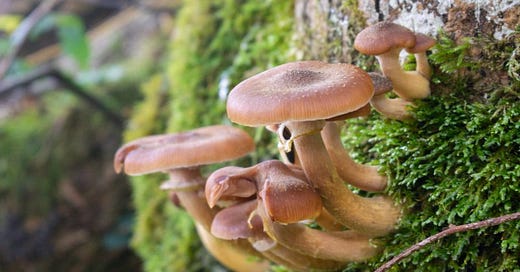Happy Friday, Fungi Friday fam!!
Man, these weeks keep flying by, can’t believe it’s already fall… where did summer go? Few quick updates, since the growing season has essentially come and gone, and we’ve STILL not successfully grown a mushroom to write home about. Had a quick meeting with the boys and I think we may be relocating the trailer, this time somewhere near a reliable power source. So the plan from here will be to connect up and go forward with a hybrid method. Hardwire the important aspects like humidity and airflow, and use solar for the intermittent needs like lighting, which is only on half of the day anyways. If we can finally get the solar to hold up for this minor purpose, we may push it’s limits a bit further, but for now, just seems it’s an un-reliable source of power for what we need.
Oh well, chins still high! I’m confident we’ll figure this puzzle out and when we do, it’ll be that much more satisfying. To end on exciting note though, picked up a few new goodies for the trailer (couple of stainless tables, a roll kart, some shelving and a ladder!! — woot woot).
Alright, enough rambling. On to the weekly features!
Mushroom leather: How fungi became fashionable
Mycelium’s magic moment. We open this week’s features with an article showcasing all of the awesome use cases that have been come up with by scientists and researchers, many of whom have been touting mycelium as the “miracle material” for years now.
Mycelium has been shown to be a worthy replacement in supplanting styrofoam, plastic, home insulation, and other substrates choking the planet. Not only that though, now designers have even taken this material and made it desirable in fashion. Sustainability-minded fashion brands like Hermes, Adidas, Gucci, and Stella McCartney are igniting the so-called “mycelium revolution,” showcasing the abundant material in covetable handbags, garments, sneakers, and furniture. And what makes it great? Well, “mushroom leather” is not at all like the cheap, synthetic pleather that you may already be familiar with. It’s as buttery, strong, and luxurious as animal hide—minus the guilt and carbon emissions. Between a deep dive on the industry, the history and the potentialities for the future, article number one this week is certainly worth a peruse.
Would you wear mushroom leather?
Why It’s Time To Include Fungi in Global Conservation Goals
While fewer than 150,000 fungi have received formal scientific descriptions and classifications to date, scientists estimate that there are between 2 million to 4 million species here on Earth.
If you enjoy bread, wine or soy sauce, or have taken penicillin or immunosuppressant drugs, thank fungi, which make all of these products possible. Except for baker’s yeast and button mushrooms, most fungi remain overlooked and thrive hidden in the dark and damp. But scientists agree that they are valuable organisms worth protecting.
As mycologists whose biodiversity work includes studying fungi that interact with millipedes, plants, mosquitoes and true bugs, we have devoted our careers to understanding the critical roles fungi play. These relationships can be beneficial, harmful or neutral for the fungus’s partner organism, but no matter beneficial or harmful, fungi are still needed. Some common tasks that fungi handle to keep out ecosystem healthy: breaking down decay and returning nutrients to the soil, degrading lignin, breaking down trees in the forest, and providing nutrition for other plants and insects. It’s not an overstatement to say that without fungi breaking down dead matter and recycling its nutrients, life on Earth would be unrecognizable. In fact, healthy ecosystems NEED fungi.
The Unexpected Way To Get Perfectly Grilled Mushrooms
Steam them first. — Yep, that’s the trick!
It seems like faulty logic to fight water with water, but steaming mushrooms before cooking them will yield the best results. Applying moist heat to mushrooms breaks down the interior air pockets providing a home to fungi's natural water content while thoroughly cooking them from the inside out. After steaming the mushrooms and allowing them to rest, drain them well at room temperature or overnight in the fridge.
Give your steamed and drained mushrooms a toss in your preferred oil and seasonings before heading to the grill for a quick sear. Grilling moisture-free mushrooms will allow the exterior to reach a perfectly charred texture while infusing their already earthy essence with a kiss of savory smoke. In addition, by steaming first, your grilled fungi can achieve a meaty texture with full flavor, making mushy mushrooms a thing of the past.
So next time you’re planning on grilling up some mushrooms, give this a try — I know i’m going to!
Want even more? Here are some other interesting, mushroom focused reads of the week:
Colorado Will Vote On Legalizing Psychedelic Mushrooms In November
Can This Smart Mushroom Invention Help Popularize Sustainable Farming At Home?
Why Magic Mushrooms Are Emerging As Major Part Of Public Discourse: Microdosing
With so many undiscovered mushrooms, citizen scientists find new species all the time
As always, thank you for reading this weeks edition of Fungi Friday’s! If you enjoyed what you found, please feel free to forward to friends also interested in the Fungi Community!
And if you were forwarded this post and enjoyed what you found, please subscribe below:




